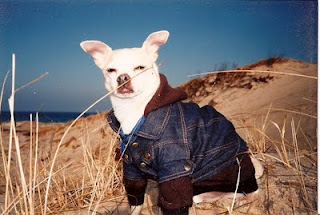
Translate
Thursday, December 24, 2009
Tuesday, December 22, 2009
Preferred running order at AKC Nationals
 And hopefully Mr. T will be this happy...
And hopefully Mr. T will be this happy...Received word from Steve Herwig, Secretary of the 2010 AKC National Agility Championship about how the Preferred jump height will be handled at the 2010 AKC National Agility Championship in Tulsa, OK.
Per Mr. Herwig:
For rounds 1, 2 and 3, the preferred and regular dogs will run at the same time as their jump height is exhibiting in each ring.
For Challengers, first all of the preferred dogs will run, (4 inches thru 20 inches), then we’ll reset the bars and run the regular dogs in the same ring immediately following (i.e. 8 inches thru 26 inches).
Same with Finals – ie. first all the preferred jump heights will run (starting with 4 inches), then we’ll reset the bars back to 8” and run the regular dogs.
I will be sending out an email blast to all who have qualified today – I’ll be sure to include this information within that blast.
From View From 4 Inch: Congratulations and best wishes to all 2010 NAC qualifiers!
Sunday, December 20, 2009
A Matter of Energy
Saturday, December 19, 2009
A Love of Lines
Earlier in my life, I loved to ski, and eventually became a ski instructor. I remember in my ski training that we learned to look for the best lines and how to ski a good line as we schussed and carved our way down the slope.
In our study of these lines, we inscribe a signature of who we are on the course. We discover the truth of our training and what we are made of as handlers.
Wednesday, December 16, 2009
AKC Agility Invitational Epic FAIL
Thursday, December 10, 2009
A Secret Santa Mission



How much is too much?
 One tough little guy. Too hard to let go.
One tough little guy. Too hard to let go.I was quite sure the dog's suffering was entirely based on the emotional needs of its owners, and that it couldn't have suffered if it had been euthanized, but the full implications were beyond me. What if the dog had been younger for instance, would that have made the suffering acceptable? And if it had, what does 'younger' actually mean? Is it less than 8 years old? Or 9? Or 8½? And if it had been young enough to make the procedure acceptable, does a dog know whether the pain will stop, even if I do?"
Tuesday, December 8, 2009
2 QQs Again
 Pictured above: A representative shot of Taylor on the fly. This particular one hangs on the wall of our club.
Pictured above: A representative shot of Taylor on the fly. This particular one hangs on the wall of our club.Tuesday, December 1, 2009
Trouble looks like this
Friday, November 27, 2009
Heeling to music
Thursday, November 26, 2009
I See Dog People
Last dog this class
And back we go to our hotel. Usually, something bare bones and simple. This time, a pleasant surprise. A real hotel. Nice cushy carpets. Dense, soft bed. It accepts pets, is the kicker, all for a basic pet hotel price. Dog and humans both, revel in our good fortune.
Sunday, November 22, 2009
2 Double Qs
The runs also counted as the fifth and sixth legs towards Taylor's MJP4 and his sixth and seventh legs toward his MXP3. His total number of double Qs for the AKC trialing year is 15.
The biggest accomplishment of the weekend, though, goes to Samurai, who managed to stay pretty calm (for him) and maintain his composure pretty decently (for him) over the two days of trialing.
For Sami, this was a pretty hard goal and we are very heartened by his improvement. Many times the hardest training jobs are those that don't earn ribbons.
Monday, November 16, 2009
Even Samurai sleeps
My puppy Samurai is a whirling dervish. Always moving, seldom stopping. But sometimes, even the wildest little dogs must succumb to the comforts of a downy pillow. When they do, they are particularly endearing. One of those blessed, rare occurrences of nature, like the sun obscured by the moon.

